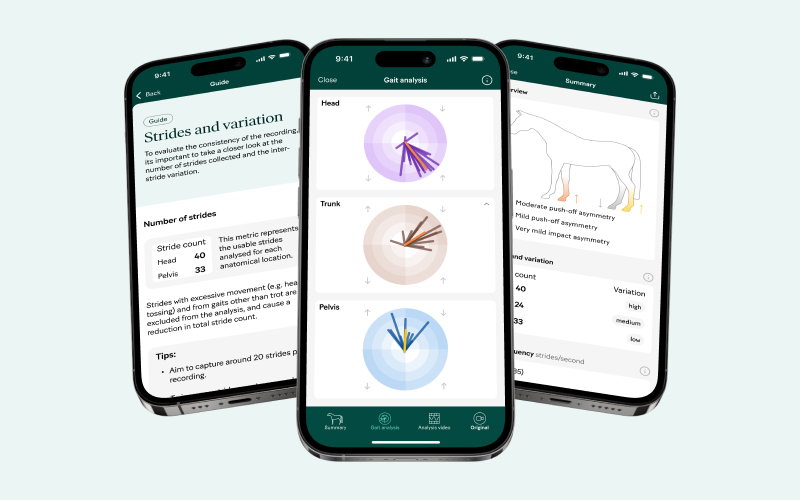Courses on objective gait analysis
Mastering objective gait analysis with leading equine biomechanics experts – Marie Rhodin and Emma Emma Persson-Sjödin

The veterinary version of Sleip now includes trunk asymmetry data. While this measurement is often referred to as “withers” asymmetry, Sleip uses the term “trunk” to reflect a broader and more robust measurement: rather than relying on a single anatomical keypoint, our system tracks multiple keypoints to analyse the motion of the horse’s trunk — even when the withers are not clearly visible.
Each new recording now includes vertical displacement measured at the trunk, shown alongside head and pelvis movement. This provides an additional reference point when assessing gait and interpreting asymmetry patterns.
By covering all three vertical movement centres — head, trunk, and pelvis — Sleip gives you a fuller picture of how the horse distributes weight and compensates for pain or dysfunction. This supports clearer interpretation and more confident identification of the primary source of lameness.
“Adding the trunk doesn’t change your workflow — but it adds context and can sharpen your insight, especially in complex lameness cases such as horses with multi-limb lameness”, comments Filipe Braganca, biomechanics researcher and product manager at Sleip
Trunk data can be especially helpful when:
When assessing weight-bearing lameness in horses, you’ll often see compensatory movement patterns. These can be misleading, and distinguishing between primary and compensatory asymmetry isn’t always straightforward. Trunk asymmetry provides an additional reference point to help determine whether the asymmetry you're observing is primary or a compensation. Trunk asymmetry offers an additional piece of the puzzle, helping you determine whether the asymmetry you're seeing is primary or compensatory.
Horses with primary forelimb lameness often display a compensatory pelvic asymmetry, mimicking a diagonal hindlimb push-off lameness. Sometimes this also appears as an ipsilateral hindlimb impact asymmetry. In such cases, trunk impact asymmetry is typically seen in the same direction as the head, supporting the interpretation that the pelvic asymmetry is secondary.

A primary hindlimb lameness often results in a compensatory ipsilateral head asymmetry. This can resemble an ipsilateral forelimb lameness in both impact and push-off phases. When this pattern appears, trunk impact asymmetry is typically in the opposite direction to the head, again helping to distinguish primary from compensatory signals.

This feature is available exclusively to veterinary users. Trunk data is included in the latest version of Sleip for vets (version 5.10.0 and above). Note that only recordings made after the release date will include trunk data. Simply update your app and start recording — no extra setup is required.
To learn more about interpreting trunk asymmetry, go to the summary or gait analysis tabs and click the “i” icon for guidance.
Have questions or feedback? We’d love to hear from you.
About Sleip
Sleip is a leading company in AI-driven gait analysis, committed to advancing equine welfare through innovative technology. Headquartered in Stockholm, Sweden, Sleip is the trusted partner of top equine veterinarians worldwide, from large clinics to solo practitioners.

Mastering objective gait analysis with leading equine biomechanics experts – Marie Rhodin and Emma Emma Persson-Sjödin

Sleip will continue its sponsorship of the EGAS Live Course 2026 — marking our 4 year supporting advanced post-graduate education in quantitative gait analysis for equine veterinarians.

SLU, Sleip, and a number of private equine clinics have collaborated on a study showing how anatomical size-scaling helps align objective gait data with visual lameness assessments